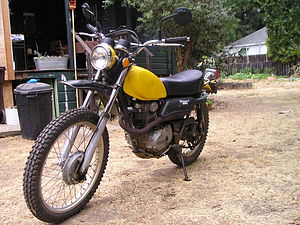Honda XL 250
| Honda | |
|---|---|
 1973 XL 250 |
|
| SL 250 / XL 250 | |
| Manufacturer | Honda |
| Sales description | Honda XL 250 |
| Production period | 1972 to 1986 |
| class | motorcycle |
| design type | Enduro |
| Motor data | |
| Air-cooled single-cylinder 4-stroke gasoline engine | |
| Displacement (cm³) | 248 |
| Power (kW / PS ) | 16.4 / 22 at 8000 rpm |
| Torque ( N m ) | 20 Nm at 6500 rpm |
| transmission | 5 courses |
| drive | Chain drive |
| Brakes | Front drum brake. Rear drum brake |
| Wheelbase (mm) | 1400 |
| Previous model | Honda SL 250 |
| successor | Honda XLR 250 |
The XL 250 is an enduro from the Japanese manufacturer Honda and was created in 1973 from a renaming of the SL 250 S , which was first launched on the market shortly before in 1972 , which, with its 4 valves and an overhead camshaft (OHC), laid the foundation for all enduros at Honda put.
Model history
In the 1960s, scramblers were very common - street motorcycles with a higher seating position, the off-road mobility of which was slightly improved by means of coarse tires and raised exhaust systems. At the end of the 1960s, Honda launched a series of SL models that initiated the transition from Scrambler to Enduro. The SL 250 came on the market in 1972 and established a series of successful and (then) modern enduros at Honda, which were manufactured until the late 80s. Since this should also be recognizable in the model name, the SL 250 was renamed the XL 250 in 1973. In Germany, the XL 250 was offered from 1974.
- SL 90 (1969)
- SL 350 (1969–1973)
- SL 175 (1970–1972)
- SL 100 (1970–1973)
- SL 70 (1971-74), renamed XL 70 in 1974 (until 1977)
- SL 125 (1971–1974)
- SL 250 (1972–), renamed XL 250 in 1973
- 1972 from 1973 XL 250
- 1975 XL 250 (K0, K1, K2)
- 1976 XL 250 K3
- 1977 XL 250 K4
- 1979 XL 250 S z
- 1980 XL 250 S a
- 1981 XL 250 S b
- 1982 XL 250 R (MD03)
- 1984 XL 250 R (MD11)
technology
Similarities
All models had drum brakes at the front and rear, whose low effect takes some getting used to, at least on the road. The machines have a relatively small oil supply, but do not have an oil pressure light or an oil filter, so regular oil checks or oil changes are highly recommended. A common problem with the engines is (similar to the larger XL 500 model ) leaks in the valve cover and cylinder head, caused by insufficiently dimensioned stud bolt threads, which after a while can no longer absorb the forces that occur.
differences
The models up to 1981 (designation "S") had a conventional swing arm with two shock absorbers, a 23 inch front wheel and a 6 volt electrical system. From 1982 (designation "R") a mono spring strut with a lever deflection was used. This system was called Pro-Link and was manufactured by the Shōwa Corporation . Furthermore, the 23-inch front wheel was replaced by a 21-inch one and the 6-volt electrical system was replaced by a 12-volt one. Among other things, the engine received a modified timing chain tensioner . The S models had a five-speed gearbox, the R models six.
successor
In 2012, Honda introduced a completely redesigned successor, the CRF 250 L.
Technical specifications
The XL 250 K3 (1976 to 1978) had the following data:
- Engine: wind -cooled OHC single cylinder with four valves
- Bore × stroke: 74 × 57.8 (mm)
- Displacement: 248 cm 3
- Compression 9.1
- Output: 20 hp (15 kW) at 7500 rpm
- Output (from 1977): 17 HP (13 kW) at 7500 rpm (the various models from 1972 to 1986 had slightly different outputs)
- Maximum torque: 19.5 Nm at 6500 rpm
- Mixture preparation: Keihin carburetor 28 mm
- Ignition: Contact ignition via flywheel magnet
- On-board power supply: 6 volts
- Power transmission
- Primary drive: helical gears, multi-disc clutch in an oil bath, claw-shift five-speed gearbox
- Secondary drive: roller chain
- Chassis: single tube frame with split beam and stereo swing arm made of tubular steel
- suspension
- front: 181 mm over telescopic fork
- rear: 105 mm over two adjustable spring struts in the spring base
- mass and weight
- Wheelbase: 1400 mm
- Trail: 140 mm
- Caster angle: 59.5 degrees
- Handlebar width: 850 mm
- Handlebar height: 1008 mm
- Seat height: 820 mm
- Ready to drive weight: 140 kg
- Tank capacity: 9 liters
- Readings
- Top speed solo 110 to 120 km / h
- Consumption 3 to 5 liters of regular petrol per 100 km (the first models required 95ROZ)
- Range 170 to 280 km
- Price: 1976: 3818 DM, 1977: 3710 DM; Prices today between 200 and 1800 euros depending on the condition
Web links
- cyclechaos.com: Honda XL250 models
Individual evidence
- ↑ a b Honda-club.net: The story of Honda Page 3, accessed April 8, 2011
- ↑ CRF250L on the Honda homepage ( memento of the original from October 8, 2014 in the Internet Archive ) Info: The archive link was inserted automatically and has not yet been checked. Please check the original and archive link according to the instructions and then remove this notice.
- ↑ bma-magazin.de: driving report and techn. Honda XL 250 K3 data , accessed April 8, 2011